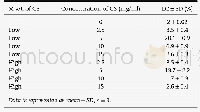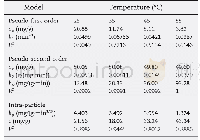《Table 5–The I-FITC release kinetic parameters from PLGAand CS coated PLGA MPs.》
 提示:宽带有限、当前游客访问压缩模式
提示:宽带有限、当前游客访问压缩模式
本系列图表出处文件名:随高清版一同展现
《Novel technique of insulin loading into porous carriers for oral delivery》
From the coefficient of determination(R 2)for kinetic plots in Fig.6 A–C,it’s apparent that the release of I-FITC from CS coated PLGA in the first 8 h fits best in the Higushi equation which indicates that the release mode is diffusion controlled(Table 5).This finding agrees with Bhattacharyya et al.,[17]and Hao et al.,[46]who examined the release from porous systems such as mesoporous silica and porous PLGA respectively.This proved that drug release from porous substrates is usually diffusion controlled,where liquid diffuses inside the pores and solubilizes the drug to be released.The release from CS based systems was also reported to be diffusion dependent[47],hence,the CS coating just slowed down the diffusion process rather than affecting the release kinetics.Although the R 2 in case of uncoated MPs was much lower than that of coated MPs,it still fitted the Higushi equation best.This linearity deviation would be due to the high initial burst achieved by the high porosity of the MPs.PLGA MPs possess large interconnected macropores which allowed large amounts of release medium to enter the particles in a short time and thus the release of the drug-dye conjugate occurred rapidly.In order to confirm the predominance of diffusion over polymer erosion in insulin release from both formulae;Kopcha equation was applied.
| 图表编号 | XD00186267100 严禁用于非法目的 |
|---|---|
| 绘制时间 | 2018.07.01 |
| 作者 | Sarah Y.Eilleia、Mahmoud E.Soliman、Samar Mansour、Ahmed.S.Geneidi |
| 绘制单位 | Department of Pharmaceutics and Industrial Pharmacy, Faculty of Pharmacy,Ain Shams University、Department of Pharmaceutics and Industrial Pharmacy, Faculty of Pharmacy,Ain Shams University、Department of Pharmaceutics and Industrial Pharmacy, Faculty of Pha |
| 更多格式 | 高清、无水印(增值服务) |





